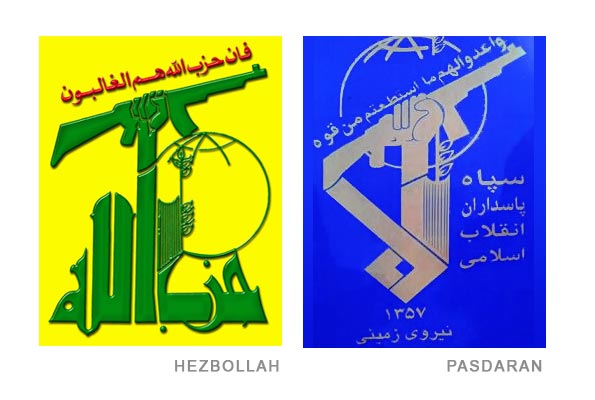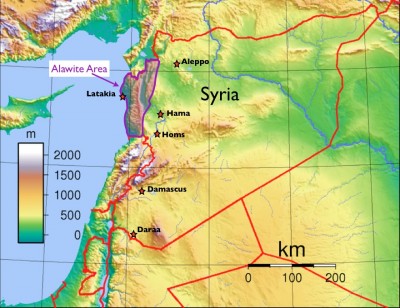 Iran and Hezbollah, its Lebanese proxy, are building a network of militias inside Syria to preserve and protect their interests in the event that President Bashar al-Assad’s government falls or is forced to retreat from Damascus, according to U.S. and Middle Eastern officials.
Iran and Hezbollah, its Lebanese proxy, are building a network of militias inside Syria to preserve and protect their interests in the event that President Bashar al-Assad’s government falls or is forced to retreat from Damascus, according to U.S. and Middle Eastern officials.
The militias are fighting alongside Syrian government forces to keep Assad in power. But officials think Iran’s long-term goal is to have reliable operatives in Syria in case the country fractures into ethnic and sectarian enclaves.
A senior Obama administration official cited Iranian claims that Tehran was backing as many as 50,000 militiamen in Syria. “It’s a big operation,” the official said. “The immediate intention seems to be to support the Syrian regime. But it’s important for Iran to have a force in Syria that is reliable and can be counted on.”
Iran’s strategy, a senior Arab official agreed, has two tracks. “One is to support Assad to the hilt, the other is to set the stage for major mischief if he collapses.”
The officials spoke on the condition of anonymity to discuss intelligence matters.
The fragmentation of Syria along religious and tribal lines is a growing concern for neighboring governments and the administration, as the civil war approaches its third year with little sign of a political solution or military victory for either Assad’s forces or the rebels.
Rebel forces, drawn largely from Syria’s Sunni majority, are far from united, with schisms along religious, geographic, political and economic lines. Militant Islamists, including many from other countries and with ties to al-Qaeda, are growing in power.
Kurdish nationalists have their own militias, with control over major swaths of the northeastern part of the country and in parts of Aleppo. They are far more interested in autonomy than in an alliance with either side in the conflict. Minority Christians have largely sided with Assad, fearing the outcome of an Islamist victory. Syria’s 700,000 Druze, followers of an offshoot of Shiite Islam, are increasingly leaning toward the rebels.
Despite U.S. efforts to convince members of Assad’s Alawite sect, itself a minority within Islam’s Shiite branch, that their interests lie in abandoning him, Alawite support remains fairly solid.
Each of Syria’s internal actors has external backers.
“Syria is basically disintegrating as a nation, similar to how Lebanon disintegrated in the ’70s to ethnic components, and as Iraq did,” said Paul Salem, director of the Beirut-based Middle East Center of the Carnegie Endowment for International Peace. “It’s going to be very hard to put Syria the nation back together.”
“We’re looking at a place which is sort of a zone, an area called Syria, with different powers,” Salem said.
Iran has a history of profiting from chaos, even without control of the government ostensibly in power. Hezbollah arose out of the Lebanese civil war of the 1970s, when Iran was able to exploit the grievances of that country’s Shiite population, a pattern it also followed in Iraq during the chaos that followed the U.S. invasion.
Tehran’s interest in preserving a Syrian base partly explains why the financially strapped Iranian government continues to lavish resources on groups such as Jaysh al-Sha’bi, an alliance of local Shiite and Alawite militias that receives weapons and cash from Iran, according to U.S. and Middle Eastern officials who have studied the organization. The groups are receiving military training from officers from Hezbollah and Iran’s Islamic Revolutionary Guard Corps (IRGC).
While ostensibly created to bolster Syria’s battered, overstretched army, Jaysh fighters — separate from Syria’s pro-regime shabiha, or “ghost,” units, which are notorious for reprisal killings of suspected rebel sympathizers — are predominantly a sectarian fighting force overseen by Iranian and Hezbollah commanders.
“Jaysh is essentially an Iran-Hezbollah joint venture,” said David Cohen, undersecretary for terrorism and financial intelligence at the Treasury Department. “Given the other constraints on Iranian resources right now, it’s obvious that this is an important proxy group for them.”
 In slapping sanctions on the militia in December, the Treasury Department said Iran had provided it with “routine funding worth millions of dollars.”
In slapping sanctions on the militia in December, the Treasury Department said Iran had provided it with “routine funding worth millions of dollars.”
A Treasury statement noted that Iran’s Revolutionary Guard commander has said that Jaysh was “modeled after Iran’s own Basij,” which it described as “a paramilitary force subordinate to the IRGC that has been heavily involved in the violent crackdowns and serious human rights abuses occurring in Iran since the June 2009 contested presidential election.”
In a divided Syria, Iran’s natural allies would include Shiites and Alawites concentrated in provinces near Syria’s border with Lebanon and in the key port city of Latakia. Under the most likely scenarios, analysts say, remnants of Assad’s government — with or without Assad — would seek to establish a coastal enclave closely tied to Tehran, dependent on the Iranians for survival while helping Iran to retain its link to Hezbollah and thereby its leverage against Israel.
Experts said that Iran is less interested in preserving Assad in power than in maintaining levers of power, including transport hubs inside Syria. As long as Tehran could maintain control of an airport or seaport, it could also maintain a Hezbollah-controlled supply route into Lebanon and continue to manipulate Lebanese politics.
Preservation of an Iranian-supported area on the coast has always been “Plan C or Plan D” for core regime supporters, Salem said. “If everything fails and they lose, they have always prepared for the fortress region . . . with everything they can cart away, even if they lose Damascus.”
“That’s not necessarily what they want,” he said. “They want to hold on to the whole thing.” But the worst-case scenario is that “the whole regime relocates to the northwest, and they still have the most powerful [armed] unit inside Syria, with a lot of the current structure.”
Newly installed Secretary of State John F. Kerry expressed during his confirmation hearing last month the administration’s concern that Syria could break apart, saying that “one of the scenarios everybody’s talking about is that people could sort of break up off into their places . . . and you could have a disintegration, and who knows where that leads?”
“These are the risks,” Kerry said. “I mean, this is what is at stake in this new world that we’re dealing with. And nobody could sit here and tell you how it all plays out.”
In a closed-door meeting of the U.N. Security Council last week, U.N. and Arab League envoy Lakhdar Brahimi cited two “big risks that are of serious concern to the international community.”
“The first is the transformation of Syria into a playground for competing regional forces, governments and non-state actors alike,” Brahimi said. “This process is largely underway.” The second risk, he said, is “full-fledged regionalization of the Syrian civil war.”
Washington Post

Leave a Reply
You must be logged in to post a comment.